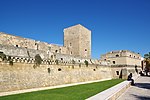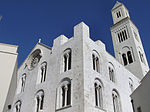HMS Hebe (J24)
1936 shipsHalcyon-class minesweepersMaritime incidents in November 1943Ships built in Plymouth, DevonShips sunk by mines ... and 3 more
Use British English from January 2017World War II minesweepers of the United KingdomWorld War II shipwrecks in the Mediterranean Sea

HMS Hebe was one of 21 Halcyon-class minesweepers built for the Royal Navy in the 1930s. Commissioned in 1936, Hebe served during World War II, notably taking part in the Dunkirk evacuation in 1940 and then serving in the Mediterranean, carrying out minesweeping operations from Malta. After taking part in several operations, including Operations Harpoon and Torch, and the invasion of Pantelleria, Hebe was sunk by a mine off Bari in November 1943, with the loss of 37 of the vessel's crew.
Excerpt from the Wikipedia article HMS Hebe (J24) (License: CC BY-SA 3.0, Authors, Images).HMS Hebe (J24)
Molo San Vito, Bari Municipio 1
Geographical coordinates (GPS) Address Nearby Places Show on map
Geographical coordinates (GPS)
| Latitude | Longitude |
|---|---|
| N 41.133333333333 ° | E 16.866666666667 ° |
Address
Molo San Vito
70122 Bari, Municipio 1
Apulia, Italy
Open on Google Maps









